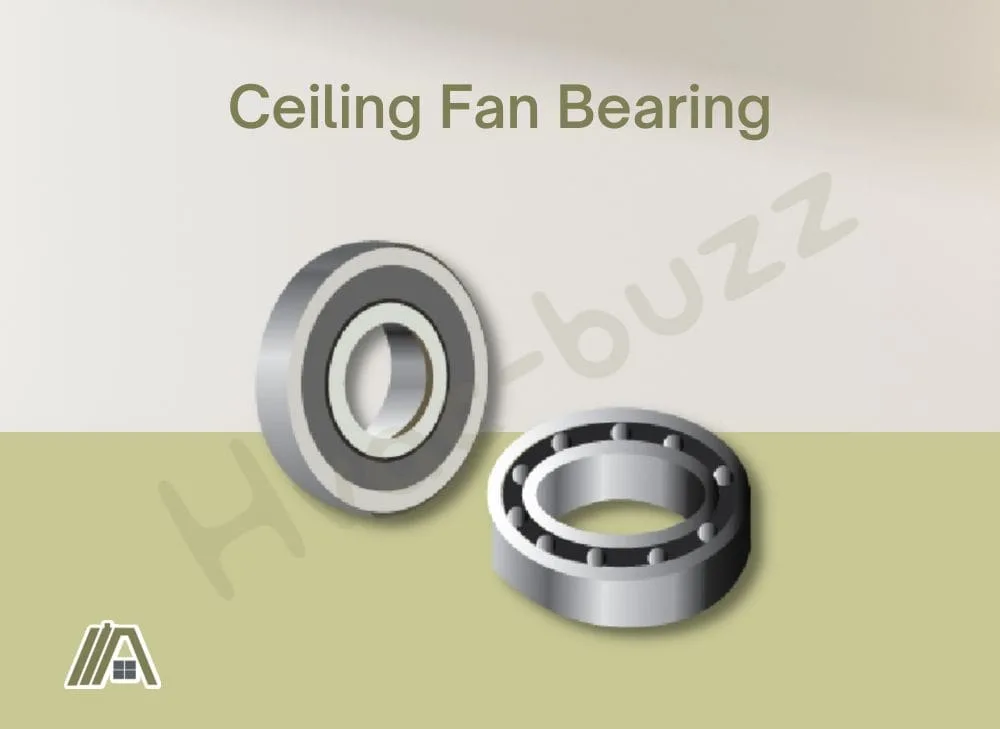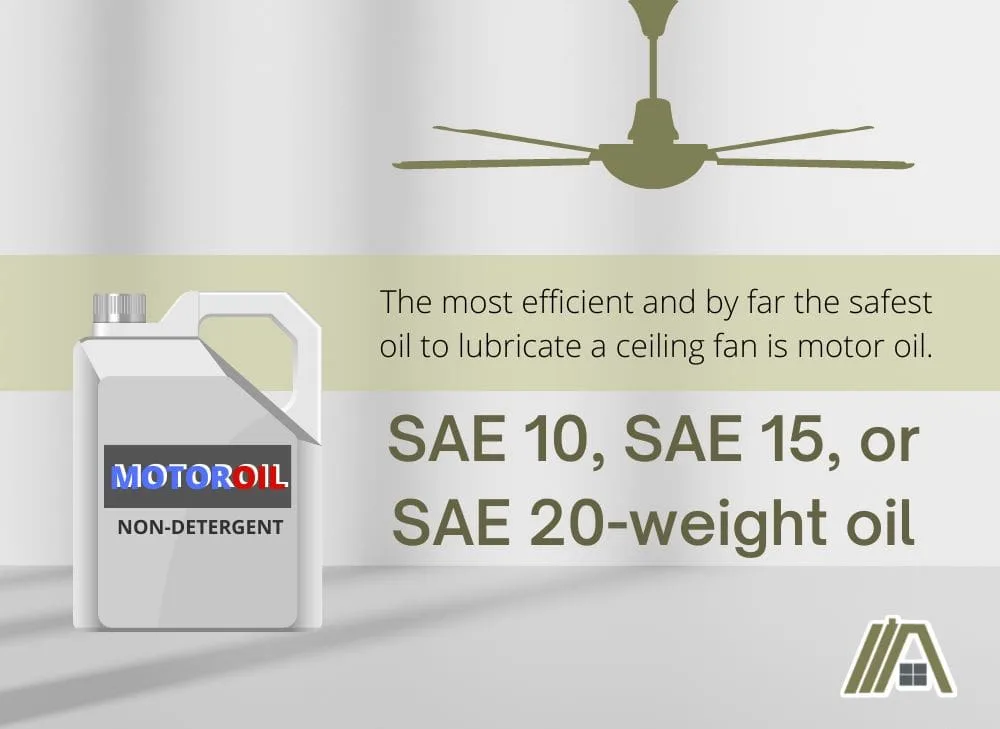When it comes to ceiling fan lubrication, the type of oil you need to use is quite specific. Unfortunately, there’s some misinformation out there that could cause you to use the wrong type of oil, which can damage the motor of your ceiling fan.
WD-40 is one of the controversial oils you will find misinformation about. So, let’s look at the good and the bad of WD-40 in terms of use on ceiling fans.

WD-40 cannot be used to lubricate ceiling fans. It is a penetrating oil with low viscosity and high volatility. This means it won’t coat the ceiling fan’s bearings and it will evaporate quickly.
Why Ceiling Fans Need Oil (Signs They Need Oiling)
Some of the most important components of every ceiling fan are the bearings.

These bearings are part of the fan’s motor system assembly, and their sole purpose is to enable smooth rotation of the blades whenever the motor is on and running. They do so by reducing friction, which reduces the power loss that the friction would inevitably cause.
For the bearing to be able to operate smoothly and efficiently, they need to be properly lubricated.
Otherwise, these essential parts of the fan’s motor could rub against each other, which would not only create friction and noise, but would ultimately wear the bearings down, compromising the fan’s function.
Nowadays, most fans have sealed bearings and are, therefore, self-lubricating. In theory, you shouldn’t ever have to oil these fans.
However, if a self-lubricating fan is old and you notice some of the signs, it may be worth your time to disassemble the motor and lubricate it (or to have an electrician do it for you).
If your fan is designed to be oiled manually, it will say so in its manual, and it will have an oil hole on the housing of the motor. Such fans can easily be lubricated even without being taken down.
Typically you will have to check and refill the oil levels of these types of fans at least once a year.
So what are the signs your fan needs oiling?
As I mentioned, the bearings ensure smooth and noise-free operation of the fan, so the first sign there is any problem are humming, buzzing, or even squeaking and clicking noises.
So, if you notice any of these noises, or if it seems like the blades are rotating poorly, it might be time to oil your ceiling fan.
WD-40 Is a Penetrating Oil
Purpose of Penetrating Oil
Penetrating oils have very low viscosity, i.e., they are more fluid-like, which enables them to better “soak into” the materials and penetrate even into very narrow spaces.
Such oils are great for getting things unstuck or for cleaning the gunk from metal. While penetrating oils are by no means corrosion stoppers, they can still help break some rust down.
This type of oil is also volatile, meaning it evaporates quickly and easily, even at normal temperatures.
How Is It Suited to This Purpose?
The volatility and low viscosity of WD-40 make it ideal for getting into small narrow spaces. This becomes very helpful when you need to loosen small things such as bolts and nuts.
It can easily get a nut unstuck, as it can penetrate into the space between the threads and loosen the nut while still allowing a good enough grip for a wrench or pliers to get hold of the nut and twist it off.
If you were to use an oil-based lubricant to loosen a nut, you would not be able to grip it afterward as the oil would have left it too slick.
Oil-based lubricants also don’t have the corrosion breakdown feature, so they wouldn’t be helpful if the nut was slightly rusted.
On the other hand, the volatility and low viscosity are the two main downsides of WD-40 when it comes to its use as a ceiling fan lubricant.
Why WD-40 Doesn’t Work on Ceiling Fans
If you decided to use WD-40 for oiling a ceiling fan, you would come across two problems.
The fact that WD-40 is volatile means that the oil would evaporate quickly, and as an end result, it would make it harder for the blades to spin as it would dry out the bearings.
This would eventually cause them to wear down, creating unpleasant noises in the process.
Secondly, since the penetrating oil is water-based oil and of low viscosity, it would not be suitable for lubricating the fan’s bearings.
Instead of spreading on the surface of the motor’s components and creating a protective layer that reduces friction, much of the WD-40 would soak into different small places and eventually evaporate.
The oil is just not thick enough to provide reliable lubrication for ceiling fans.
That said, WD-40 can still be used in ceiling fans. In some cases, it could actually be quite handy in cleaning the motor and getting rid of all of the gunk.
However, it is important to always finish this type of cleaning of a motor with actual motor lubrication.
Caution: Makers Recommend WD-40 for Ceiling Fan
You would assume that the makers of WD-40 are well aware of both its strong suits and downsides and would, therefore, provide the best recommendations on how to use this product. The problem is that this is not the case.
On their website, its makers state that WD-40 is suitable for ceiling fan lubrication. They should not be recommending this.
The fact remains that WD-40 is not ideal for oiling a ceiling fan for the reasons I have covered in the previous section.
Motor Oil is the Best for Ceiling Fans
By now, it is likely no surprise that the most efficient and by far the safest oil to lubricate a ceiling fan is motor oil. Of course, only as long as the oil is suitable for electric motors
Different manufacturers might advise using a different grade (maybe even type) of oil. More specifically, most manufacturers recommend using either SAE 10, SAE 15, or SAE 20-weight oil.

One important thing that all manufacturers agree on is that the motor oil should be non-detergent. Oils with detergent have the potential to gum up the bearings and completely damage the motor.
Sources
https://hvacseer.com/do-ceiling-fans-need-to-be-oiled/
https://www.hunker.com/13416378/how-to-oil-a-ceiling-fan
https://en.wikipedia.org/wiki/Penetrating_oil

![WD-40 Multi-Use Product with SMART STRAW SPRAYS 2 WAYS, 12 OZ [12-PACK] WD-40 Multi-Use Product with SMART STRAW SPRAYS 2 WAYS, 12 OZ [12-PACK]](https://m.media-amazon.com/images/I/31R1Uza1KdS._SL500_.jpg)